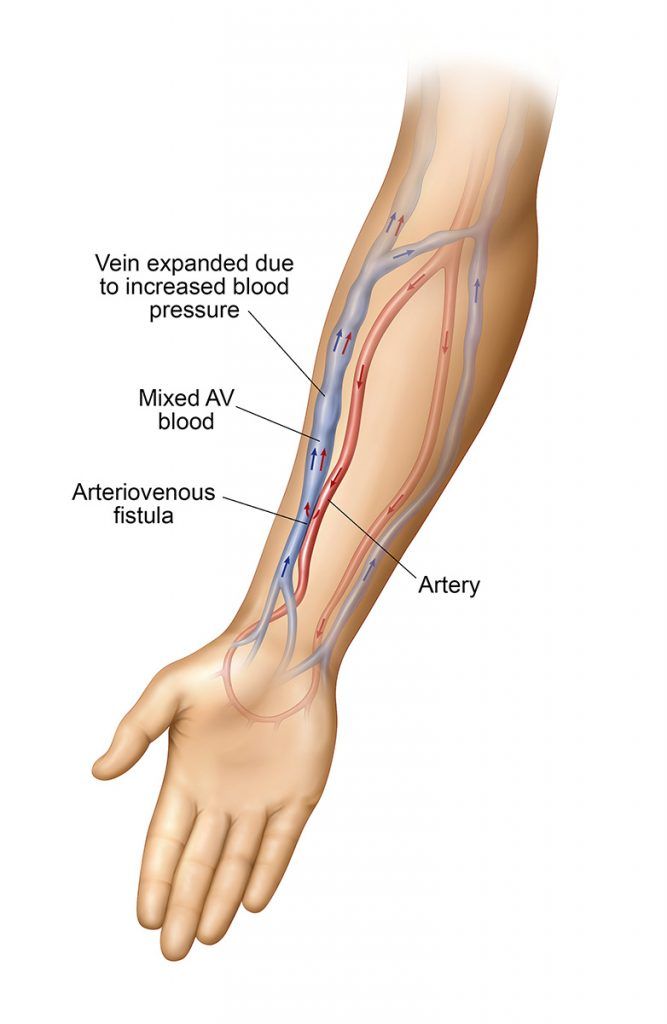
Rotating needle placement sites is an important part of caring for your arteriovenous (AV) fistula. This practice helps prolong the life of your dialysis access and reduces the risk for an aneurysm, which can happen when the repeated insertion of needles in one spot causes the wall of a vein to stretch and weaken. However, using sharp needles to make new holes in your skin on a repeated basis can be quite painful and uncomfortable. The buttonhole technique is an option for those who want to avoid the pain and discomfort associated with rotating needles at their access site.

Here’s more information about the buttonhole technique and why it’s considered useful in hemodialysis.
What Is the Buttonhole Technique?
Also known as “constant site” cannulation, the buttonhole technique is a less painful form of cannulation compared with other cannulation techniques. (i) With the buttonhole technique, needles are inserted into the exact same place at the exact same angle during every dialysis session. This leads to the creation of a tunnel into which, blunt-tipped needles are inserted instead of sharp, pointed needles. The tunnel is formed by scar tissue, and is similar to the way tunnels are formed by scar tissue in the earlobes when you get your ears pierced.
The buttonhole technique can only be used by those who have an AV fistula. (ii) The walls of an AV fistula have muscle fibers that close after a needle is removed, which help prevent excess bleeding following each dialysis session. (i) Buttonhole tract development requires about six to twelve cannulations for the tunnel to form. The term “buttonhole” refers to the two holes the needles create through your skin and into the AV fistula wall—both of which resemble actual buttonholes.
With proper care and management, your buttonhole will result in less pain and discomfort during dialysis sessions and can serve as the permanent entry points into your dialysis access. The buttonhole technique can either be used by those who prefer to self-cannulate at home, or by those who prefer having needles inserted by a dialysis nurse or technician at a dialysis clinic. (ii)
What are the Pros and Cons of the Buttonhole Technique?
The buttonhole technique makes it easier for dialysis patients to perform self-cannulation, especially those who perform dialysis in the comfort of their own homes. This cannulation technique is also found to be less painful than other techniques because the buttonhole technique allows patients to use a blunt needle. This technique is also often preferred by those who have a fear of sharp needles and who want to feel more comfortable performing self-cannulation. (i)
One of the largest cons to the buttonhole technique is having to invest time in learning how to properly self-cannulate if you decide to go this route. An experienced hemodialysis nurse or technician will work with you on mastering this technique so you can do it yourself conveniently in the privacy of your home. Another potential downside associated with the buttonhole technique is the risk for infection at the buttonhole sites. However, taking proper care of your dialysis access can keep your buttonhole open and safe against infection for the lifespan of your dialysis treatment.
Tips on Caring for Your Buttonhole Site
The steps you must take to properly care for your buttonhole site are similar to those already included as part of dialysis access care. (iii) Washing your hands and the access site is important before performing dialysis to reduce the risk for infection. (iii) Using a clean, sterile needle is also critical for reducing the risk of infection.
If you are going to self-cannulate here are other steps to take when caring for your dialysis access:
- Always wear gloves to prevent the spread of germs and bacteria.
- Always wear a mask when inserting and removing needles.
- Disinfect the site before removing scabs from the buttonhole sites.
- Always remove scabs from the buttonhole sites before beginning dialysis.
- Insert needles using the exact same angle and depth every time to create and maintain a properly functioning buttonhole tract. Failing to insert needles in the same spot may increase your risk for aneurysms. This could also lead to the creation of extra tunnels that bacteria can hide in and prevent you from switching over to dull needles from sharper, more painful needles. (ii)
- Remove needles one at a time and hold the site together using two fingers. This covers both the hole in your arm and the hole in your AV fistula and prevents blood from filling the tunnel to create a large blood clot. Instead, this results in the formation of smaller scabs that heal more quickly. (ii)
If you’re on dialysis with an AV fistula, contact your nephrologist or dialysis care team to learn more about the buttonhole technique.
Sources:
(i) Mott, S. (2010). A how-to manual: The art of teaching buttonhole self-cannulation. Retrieved February 23, 2019,
https://homedialysis.org/documents/pros/StuartMott_ButtonholeCannulation_06_19_17.pdf.
(ii) National Kidney Foundation. (n.d.). The buttonhole technique. Retrieved February 23, 2019, from https://www.kidney.org/atoz/content/buttonhole-technique.
(iii) Medline Plus. (2016, November 11). Taking care of your vascular access for hemodialysis. Retrieved February 23, 2019, from https://medlineplus.gov/ency/patientinstructions/000591.htm.


